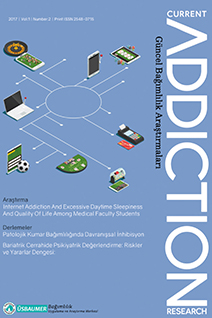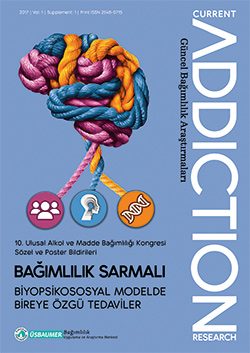Years
2022
2018
2017
Categories
Authors
ARTICLES
Original Article
Erkal ERZİNCAN,Bülent COŞKUN,Nermin GÜNDÜZ
2022, 6(1), s:25-39
Original Article
Sociodemographic Examination of Patients Applying to Probation Policlinic in Erzurum Province
Fatma Eren,Nermin Gündüz,Hatice Turan,Erkal Erzincan
2018, 2(1), s:11-16
Objective: In this first study on the patients who applied to the Probation Ward in the Eastern Anatolian Region of Erzurum province, it is aimed to compare the sociodemographic data of the patients with the substance use characteristics and other legal crimes.
Method: Between December 2015 and February 2016, 132 patients who applied for the first time to the Erzurum DS polyclinic were included in the study. The sociodemographic data form prepared by the researchers participating in the research was applied.
Results: All of the 132 cases involved in the study were men. While 49.2% of the patients had multiple substance use, cannabis was found to be the highest substance alone at 45.4% level. We found that smoking and alcohol use started earlier than substance use and that alcohol and cigarette use were high. Considering the impact of multiple substance use on the sociodemographic data, a significant difference was found between early substance use age, substance abuse existence in the past month, the first cigarette smoking age, self-harm behavior presence, the existence of additional criminal cases and the existence of previous psychiatric treatment history. There was a significant positive correlation between the age of first substance use and the age, the age of first cigarette use and the age of first alcohol use. Finally, when the groups with and without prison stories are compared in terms of self-harm behavior, a significant difference was found.
Conclusion: Reviewing the sociodemographic data of individuals with probation application will guide clinicians in defining the group in which more preventive measures will be taken for substance use.
Original Article
Nermin Gündüz,Özge Timur,Erkal Erzincan,Hatice Turan,Onur Gökçen,Fatma Eren,Aslıhan Polat
2017, 1(2), s:56-63
Objective: Considering the increasing use of the internet among university students, medical faculty students are thought to be particularly sensitive because of the time they spend on the internet and because of intensive practical and theoretical course schedules. In this study, we aimed to examine the prevalence of internet addiction and also relationship between internet addiction and excessive daytime sleepiness and quality of life. among the medicine faculty students. We aimed to examine the prevalence of internet addiction and also relationship between internet addiction and excessive daytime sleepiness and quality of life among medical faculty students.
Method: This study was carried out among the students of Erzurum Atatürk University Medical Faculty. In this cross-sectional study, sociodemographic data form created by researchers, Young Internet Addiction Scale, SF-36 and Epworth Sleepiness Scale were applied after the signing of the voluntary affirmation document to the medical faculty students.
Results: A total of 274 medical faculty students from various classes were included in the study. 61,32% of the students were found to have internet addiction. 53.28% of them were at mild level, 8,04% of them were at moderate level. There was a positive correlation between internet addiction scale total score and epworth sleepiness scale total score. There was negative correlation between internet addiction and each subscale of SF 36.
Conclusion: This study is the first study to evaluate internet addiction, excessive daytime sleepiness and quality of life among medical faculty students. In our study group internet addiction was determined as one of the reasons for excessive daytime sleepiness. That’s why we must focus on the treatment of internet addiction which is a serious problem in social context in recent years.



 2. Sayı
2. Sayı
 1. Sayı
1. Sayı
 Ek Sayı
Ek Sayı







